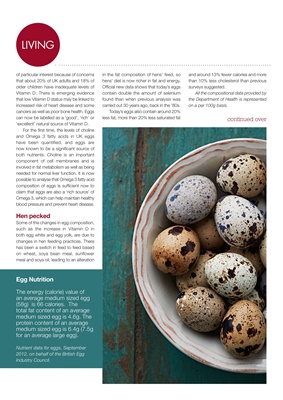
LIVINGLIVING
continued over
D is of particular interest because of
concerns of about 20% of UK adults and
18% of older children have inadequate
levels of Vitamin D and because there
is emerging evidence that low Vitamin D
status may be linked to increased risk of
heart disease and some cancers as well
as poor bone health. Eggs can now be
labelled as a 'good', 'rich' or 'excellent'
natural source of Vitamin D. Choline is an
important component of cell membranes
and is involved in fat metabolism as well
as being needed for normal liver function.
It is now possible to analyse that Omega 3
fatty acid composition of eggs is sufficient
now to claim that eggs are a 'rich source'
of Omega 3.
Hen pecked
Some of the changes in egg composition,
such as the increase in Vitamin D on
both egg white and egg yolk, are due to
changes in hen feeding practices. There
has been a switch in feed to feed based
on wheat, soya bean meal, sunflower
meal and soya oil, leading to an alteration
in the fat composition of hens' feed. So
hens' diet is now richer in fat and energy.
Official new data shows that today's eggs
contain double the amount of selenium
found than when previous analysis was
carried out 30 years ago, back in the '80s.
For the first time, the levels of choline
and Omega 3 fatty acids in UK eggs have
been quantified, and eggs are now known
to be a significant source of both nutrients.
Today's eggs also contain around 20%
less fat, more than 20% less saturated fat
Egg Nutrition
The energy (calorie) value of
an average medium sized egg
(58g) = 66 calories. The total fat content of an average
medium sized egg = 4.6g. The
protein content of an average
medium sized egg = 6.4g (7.5g
for an average large egg). Nutrient data for eggs, September
2012, on behalf of the British
Egg Industry Council.
and around 13% fewer calories and more
than 10% less cholesterol than previous
surveys suggested.
All the compositional data provided by
the Department of Health is represented
on a per 100g basis.